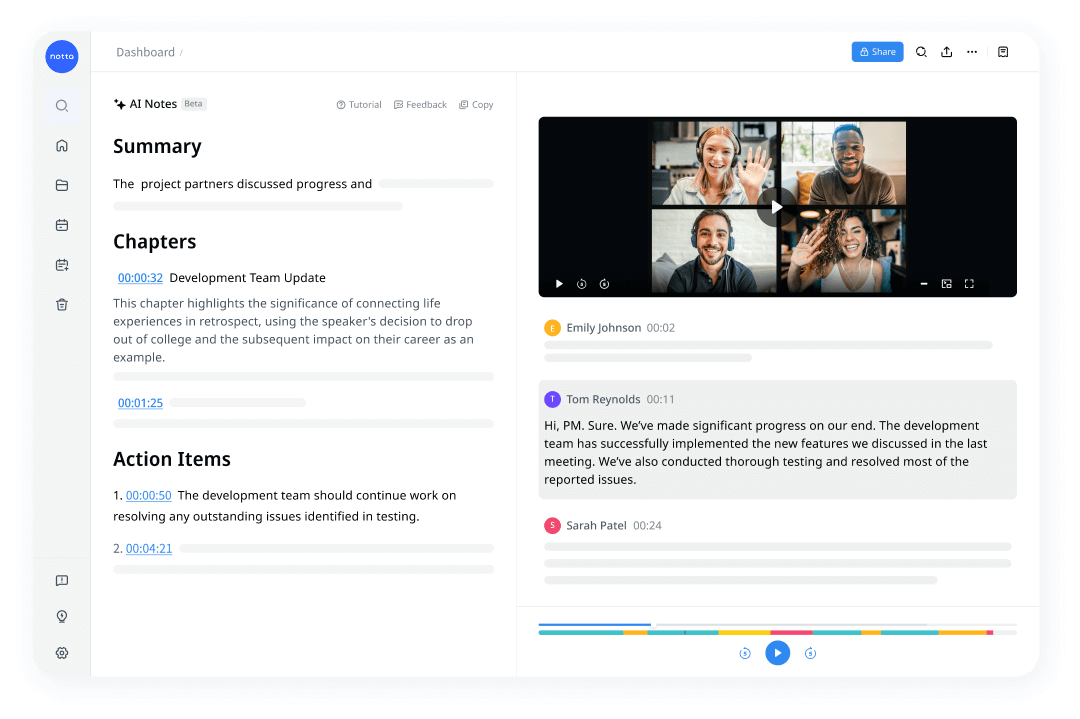
How to Set Meeting Goals and Objectives for Success
Unlock the power of AI — Notta's meeting assistant records, transcribes and summarizes meeting minutes with one click.
Meetings serve as a platform for collaboration and decision-making in the workplace. However, without well-defined goals, meetings can become aimless and unproductive.
Setting clear goals and objectives for your meeting keeps discussions on track and stay focused. Over several months, this will save hundreds of hours. Feel free to use this extra time to develop your product, better the customer experience, and optimize your marketing strategy.
In this post, we will explore the importance of meeting goals, the different types of meeting goals, and how to set one that transforms your meetings into purposeful and outcome-driven sessions.
What are meeting goals?
Meeting goals refer to the primary objectives that guide the purpose, content, and outcome of a meeting.
Depending on your team, you could have multiple smaller meeting goals or one sizable target that everyone's working towards.
It’s advisable to jot down the objectives in your meeting agenda. Teammates can work together to reach these targets, and if something unimportant pops up, write it in the side column and get back to it after you've reached your goals.
Why are meeting goals important to have?
Setting objectives are essential when running a team meeting because:
1. It keeps your meetings on track
The biggest advantage to setting meeting objectives is that everyone's on the same page and focused on achieving two or three specific goals.
Most meetings waste precious hours you could've been spending on your craft.
But when you have a predetermined meeting purpose, everyone can prepare and side discussions are easy to spot.
2. It boosts productivity
Because everybody is focused on just a few goals, team members can get more done, and communicate information within a shorter time frame.
For example, if your competition spends two hours talking about sales performance, you might be able to cover the same points in 30 minutes using meeting goals. This gives employees more time to sell and learn about persuasion.
Over several months and years, you’re saving hundreds of hours.
3. It lowers costs of meetings
Meetings are surprisingly expensive. Research shows companies in the United States spend over $37 billion per year on team meetings.
But there are also hidden fees to watch out for. Let's say the average salesperson brings in $50 per hour. If your weekly meetings are two hours long and only one hour is productive, you're spending $2,600 a year per salesperson. If you're employing six salespeople, that's over $15,000 per year.
Fortunately, a meeting goal lowers this cost, giving you more money to scale your business and empower your team.
6 types of meeting goals
According to experts, there are various types of meeting goals that can be set based on the specific objectives of the meeting. Some common types of meeting goals include:
Planning goals: These goals focus on outlining strategies, allocating resources, and defining action plans for projects or initiatives. They help team members understand their focus and purpose within the larger context of the organization's objectives.
Problem-solving goals: These goals aim to identify and address challenges or obstacles faced by the team or organization. Problem-solving meetings encourage brainstorming, analysis, and collaborative decision-making to find effective solutions.
Decision-making goals: Decision-making meetings are designed to reach conclusions or make choices on specific issues or initiatives. The goals involve evaluating options, gathering relevant information, and reaching a consensus or making informed decisions.
Relationship building goals: These goals focus on fostering positive relationships, trust, and collaboration among team members or stakeholders. Relationship-building meetings provide opportunities for networking, team bonding, and improving communication channels.
Evaluation and feedback goals: These goals aim to assess progress, provide feedback, and make necessary adjustments in ongoing projects or processes. Evaluation meetings help identify strengths, weaknesses, and areas for improvement to enhance overall performance.
Team alignment goals: These goals focus on aligning team members' understanding, expectations, and efforts towards a common vision or goal. Team alignment meetings ensure everyone is on the same page, promotes clarity, and enhances teamwork and coordination.
With Notta, you can easily generate meeting minutes, turning spoken content into written records with 98.86% accuracy.
Meeting goals examples
If you're short on ideas, use these three examples to inspire your meeting objectives.
1. Human resources meeting example
If you're in the process of hiring employees and you're sitting down with your team to lower the number of potential candidates, consider this template:
"Our meeting objective is to reduce the current pool of applicants down to three, so we can set up interviews with them next week."
2. QBR meeting example
This example works well if you're hosting a video call with clients to gather feedback about your product.
"Our primary goal for this session is to find areas where our product is lacking so we can focus development on the correct features."
3. Performance review meeting example
But if you're meeting with management to make decisions regarding performance, use this template:
"Our meeting goal is to identify areas for improvement and assign learning material to individuals so we can get better as a team."
How to set effective meeting goals in 5 steps
Here's how to set meeting objectives in five simple steps:
Identify your desired outcome
Summarize your meeting objectives clearly
Ensure your goals are actionable
Share team objectives with members
Measure your progress
Step 1: Identify your desired outcome
The first step is to think about why you're running this meeting and the optimal results you’re trying to achieve.
To record desired outcomes, you could jot it down on paper or type it directly into your meeting agenda.
But when you're identifying meeting objectives, it's important to avoid using financial performance because it’s a result of sales and marketing operations. Most people also don't relate to financial goals well.
Instead of making your goal a specific sales figure, aim to provide salespeople with the feedback and knowledge needed to reach this number.
Step 2: Summarize your meeting objectives clearly
Next, summarize your meeting purpose into one or two sentences, so it's easy to understand.
For example, if you're running a QBR meeting, your goal could be:
"During this session, we aim to receive feedback on what our product is doing well and how we can improve the customer experience."
This one sentence tells your client everything they need to know, and they'll be able to gather a list of modifications you can make to your product.

Step 3: Ensure meeting objectives are actionable
Although your goals shouldn’t be too easy, avoid setting intimidating objectives. This puts stress on participants and results in meetings that aren't actionable.
Instead, break your goal into bite-sized pieces that members can achieve within a few minutes.
For instance, rather than creating a goal like outsourcing the work of an entire project, identify each step and assign these smaller goals to participants.
Step 4: Share your team objectives with members
Once you've summarized your meeting goals and ensured they're actionable, it's time to share them with team members. Do this at least 24 hours before the meeting since it gives everyone a chance to prepare.
For example, if you forward a plan to your team with objectives that say you want to create three digital posters for a client's new product, employees can brainstorm in their free time and design potential posters.
Step 5: Measure your progress
The last step is measuring progress towards team goals. This lets you understand if meetings are productive and where to improve.
If you're reviewing your team's performance, your goal could be to provide feedback on three key areas that will allow members to boost work quality. If you fail to reach your goals regularly, assess areas of meetings that are taking up time. Maybe your introductions are too long, or the Q&A sessions tend to drag out.
By measuring progress, you optimize meeting operations and get more done in less time.
Notta offers the most integrated AI meeting notes, summaries, and action items so nothing gets missed.
Final thoughts
Setting goals plays a critical part in running productive and time-efficient meetings. It highlights the importance of the session while allowing members to prepare.
So if you're looking to optimize meeting productivity and engagement, consider this five-step process. And if you need some inspiration, copy and paste the three example templates listed above.